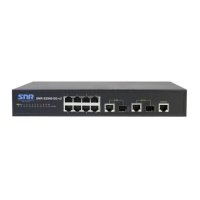SNR S2940-8G-v2 Switch Configuration Guide
EFM OAM Configuration
10.1.3 Remote Fault Detection
In a network where traffic is interrupted due to device failures or unavailability, the flag field de-
fined in Ethernet OAMPDUs allows an Ethernet OAM entity to send fault information to its peer.
As Information OAMPDUs are exchanged continuously across established OAM connections, an
Ethernet OAM entity can inform one of its OAM peers of link faults through Information OAMP-
DUs. Therefore, the network administrator can keep track of link status in time through the log
information and troubleshoot in time.
There are three kinds of link faults for Information OAMPDU, they are Critical Event, Dying
Gasp and Link Fault, and their definitions are different for each manufacturer, here the definitions
are as below:
Critical Event: EFM OAM function of port is disabled.
Link Fault: The number of unidirectional operation or fault can not be less than the high thresh-
old in local. Unidirectional Operation means unidirectional link can not work normally on full-duplex
link without autonegotiaction. EFM OAM can detect the fault and inform the remote OAM peers
through sending Information OAMPDU.
Dying Gasp: There is no definition present. Although device does not generate Dying Gasp
OAMPDU, it still receives and processes such OAMPDU sent by its peer.
Figure 10.2: Typical OAM application topology
10.1.4 Remote loopback testing
Remote loopback testing is available only after an Ethernet OAM connection is established. With
remote loopback enabled, operating Ethernet OAM entity in active mode issues remote loopback
requests and the peer responds to them. If the peer operates in loopback mode, it returns all pack-
ets except Ethernet OAMPDUs to the senders along the original paths. Performing remote loop-
back testing periodically helps to detect network faults in time. Furthermore, performing remote
loopback testing by network segments helps to locate network faults. Note: The communication
will not be processed normally in remote loopback mode.
Typical EFM OAM application topology is in the following, it is used for point-to-point link and
emulational IEEE 802.3 point-to-point link. Device enables EFM OAM through point-to-point con-
78

